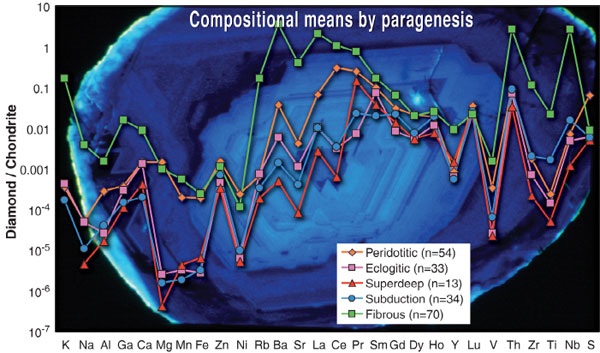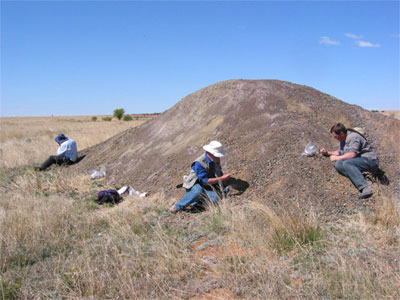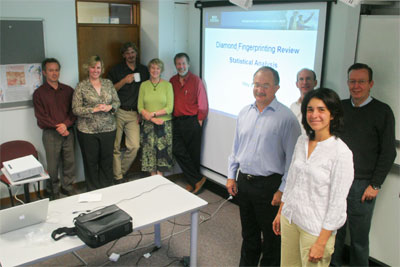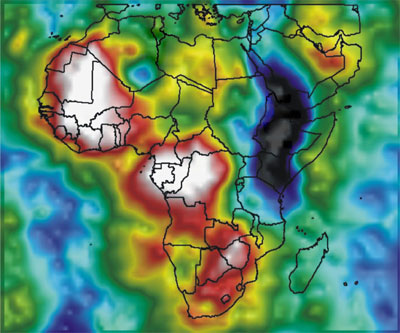Industry interaction
 |
 |
 |
 |
INDUSTRY INTERACTION, TECHNOLOGY TRANSFER AND COMMERCIALISATION PROGRAM
GEMOC relies on a vigorous interaction with the mineral exploration industry at both the research and the teaching/training levels. The research results of the Centre’s work are transferred to the industry and to the scientific community by:
• collaborative industry-supported Honours, MSc and PhD projects
• short courses relevant to the industry and government sector users, designed to communicate and transfer new technologies, techniques and knowledge in the discipline areas covered by the Key Centre
• one-on-one research collaborations and shorter-term collaborative research on industry problems involving national and international partners
• provision of high quality geochemical analyses with value-added interpretations in collaboration with industry and government organisations, extending our industry interface
• use of AccessMQ consultancies and collaborative industry projects, which employ and disseminate the technological developments carried out by the Centre
• GLITTER, an on-line data-reduction program for Laser Ablation ICPMS analysis, developed by GEMOC and CSIRO GEMOC participants, has been successfully commercialised and is available from GEMOC through AccessMQ (http://www.es.mq.edu.au/GEMOC/)
• collaborative relationships with technology manufacturers (more detail in the section on Technology Development)
• GEMOC (Macquarie) is the Australian demonstration site for Agilent Technologies LAM-ICPMS applications
• GEMOC (Macquarie) is an international test site for New Wave Research Lasers
SUPPORT SOURCES
GEMOC industry support includes:
• direct funding of research programs
• "in kind" funding including field support (Australia and overseas), access to proprietary databases, sample collections, digital datasets and support for GIS platforms
• logistic support for fieldwork for postgraduate projects
• collaborative research programs through ARC Linkage Projects and the Macquarie University External Collaborative Grants (MUECRG) and PhD program support
• assistance in the implementation of GIS technology in postgraduate programs
• participation of industry colleagues as guest lecturers in undergraduate units
• extended visits to Macquarie by industry personnel for interaction and research
• ongoing informal provision of advice and formal input as members of the Advisory Board
ACTIVITIES IN 2007
10 Industry Reports were completed for collaborative industry projects.
TerraneChron® studies (see Research Highlights) have enjoyed continued uptake by a significant segment of the global mineral exploration industry. This methodology, currently unique to GEMOC, requires the integration of data from three instruments (electron microprobe, LAM-ICPMS and LAM-MC-ICPMS) and delivers fast, cost-effective information on the tectonic history (with ages) of regional terranes (www.es.mq.edu.au/GEMOC/TerraneChron.html).
The ARC Linkage Project titled “Global Lithosphere Architecture Mapping” (GLAM) continued with full industry partner support following the takeover of WMC Resources by BHP Billiton. Planning and workshop sessions at Macquarie with participants from BHP Billiton and GEMOC, and visits by Macquarie researchers to Perth, were key activities in 2007, leading to a successful application for a new 3-year Linkage Project. Dr Graham Begg spent significant research time at GEMOC through 2007 as part of the close collaborative working pattern for this project.
GEMOC’s development of a method to analyse trace elements in diamond has opened up potential further developments and applications relevant to industry, ranging from diamond fingerprinting for a range of purposes to improving the knowledge framework for diamond exploration. Rio Tinto supported a successful ARC Linkage Project application on Diamond Fingerprinting. Dr Debora Araujo has been employed as a Research Associate on the project and has carried out an extensive program of method development and diamond analysis.
A continuing collaborative research relationship with New South Wales Geological Survey is applying TerraneChron® to investigations of the provenance of targeted sequences in Paleozoic sedimentary terranes of eastern Australia.
BHP Billiton continued to support a project exploring a novel framework for the origin of magmatic Ni-deposits in 2007, following the previous successful project with WMC on Continental Flood Basalts related to Ni and PGE deposits (see GEMOC publication #473).
The alliance with PIRSA (Primary Industries and Resources, South Australia) applying TerraneChron® to collaborative projects has expanded with funding of a new collaborative research proposal for 2008.
Industry visitors spent varying periods at GEMOC in 2007 to discuss our research and technology development (see visitor list, Appendix 3). This face-to-face interaction has proved highly effective both for GEMOC researchers and industry colleagues.
DIATREEM continued to provide LAM-ICPMS analyses of garnets and chromites to the diamond-exploration industry on a collaborative basis.
GEMOC publications, preprints and non-proprietary reports are available on request for industry libraries.
GEMOC was prominent in delivering keynote and invited talks and workshop modules at national and international industry peak conferences in 2007 including the 7th Biennial Exploration Managers Conference of AMIRA (Australian Minerals Industry Research Association), the Exploration 07 Conference in Toronto, and the Ores and Ore Genesis Conference (Tucson, Arizona, USA). See Appendix 4 for abstract titles and GEMOC Publication #491.
 |
 |
 |
 |
CURRENT INDUSTRY-FUNDED COLLABORATIVE RESEARCH POJECTS
These arre brief descriptions of current gemoc projects that have direct cash support from industry with either formal ARC or Macquarie University Grant status, and timeframes of at least one year. Projects are both national and global. In addition to these formal projects, many shorter projects are directly funded by industry alone, and the results of these feed into our basic research database (with varied confidentiality considerations). Such projects are administered by AccessMQ, Macquarie’s commercial entity.
GEMOC’s industry collaborative projects are designed to develop the strategic and applied aspects of the basic research programs based on understanding the architecture of the lithosphere and the nature of Earth’s geodynamic processes that have controlled the evolution of the lithosphere and its important discontinuities. Most of the industry collaborative projects rely on geochemical information from the Geochemical Analysis Unit in GEMOC and especially on novel methodologies developed by (and some unique to) GEMOC.
Geochemical data on crustal and mantle rocks are being integrated with tectonic analyses and large-scale datasets (including geophysical data) to understand the relationship between lithosphere domains and large-scale mineralisation.
The new methodologies of using mantle sulfides to date mantle events, and of characterising crustal terrane development using U-Pb dating and Hf isotopic compositions of zircons provide more information for integration with geophysical modelling (see Research Highlights). TerraneChron® (see Research Highlights) is proving an important new approach to characterising the tectonic history and crustal evolution of terranes on the scale of 10 – 100 km as well as delivering a cost-effective exploration tool to the mineral (and potentially petroleum) exploration industry.
The recent breakthrough in developing a robust methodology to analyse the trace elements in diamonds quantitatively is another world-first for GEMOC. In addition to providing a unique knowledge base about the nature and compositions of deep mantle fluids that has led to a new hypothesis for how diamonds form in the Earth’s mantle (see Research Highlights), it has potential practical applications to diamond fingerprinting for forensic applications and to better predicting global targets for diamond exploration.
Formal projects known to be funded for 2008:
Basin development in Proterozoic South Australia: developing a time-integrated, compositional framework to assist mineral explorationSupported by a matching Macquarie University External Collaborative grant
|
Formal projects commencing 2007:
Global Lithosphere Architecture Mapping II
|
Trace element analysis of diamond: new applications to diamond fingerprinting and genesis
|
Formal projects active in 2007:
Lithosphere evolution across a craton margin, southern AfricaSupported by Industry and a matching Macquarie University Collaborative Grant Summary: The margins of cratonic blocks extend to 150-300 km depth, and exert a strong control on crustal tectonics. Kimberlite magmas intruded across the southern margin of the Kaapvaal Craton (S. Africa) provide detailed sampling of the lithospheric mantle. We will use these samples to map the composition and structure of the mantle in two time slices (120 Ma, 90 Ma), providing new information on how the craton margins channel fluids. Linkages between crustal tectonics and mantle events are being constrained by comparing TerraneChron® analysis of zircons from modern streams, and the kimberlites themselves, with existing Re-Os ages for mantle rocks.
Bill Griffin and Alan Kobussen picking over a concentrate pile during a trip to South Africa. |
Trace-element Analysis of DiamondsSupported by Industry and a matching Macquarie University Collaborative Grant Industry Collaborator: Rio Tinto Summary: Diamonds contain minute amounts of trapped fluids, representing the medium from which the diamonds grew; these fluids are a unique source of information on processes in Earth’s mantle. New techniques for the trace-element analysis of these fluids, developed recently in GEMOC were further developed, and applied to the analysis of selected populations of diamonds from the Argyle mine (WA). The data will provide new insights into the genesis of diamond, with applications both to exploration models and to test the feasibility of “fingerprinting” of diamonds for exploration and forensic purposes (tracing illegal diamond sources). This project led to the ARC Linkage Grant for 2007.
Rio Tinto came to GEMOC for a project review meeting L-R: John Takos, Esmé van Achterbergh (GEMOC PhD 2005), Paul Agnew, Sue O’Reilly, Bill Griffin, Phil Plaisted, John Chapman, Debora Araujo, Norm Pearson. |
Global Lithosphere Architecture Mapping
|
Links between plume-mantle interaction, mantle sulfides and Ni-PGE endowment in Large Igneous Provinces
|
Mechanisms of PGE fractionation and concentration in mafic and ultramafic meltsSupported by AMIRA and MERIWA and an international postgraduate scholarship from Macquarie University Summary: A long-standing goal of research on nickel-sulfide (NiS) deposits has been the development of reliable lithogeochemical indicators that can act as guides for exploration. In order to better constrain how platinum-group element (PGE) signatures may be utilised as pathfinders for those NiS deposits, this project focuses on the processes that control the fractionation and concentration of PGE in mafic and ultramafic magma types. The study looks into a range of variables controlling the PGE geochemistry, including the role of sulfides (i.e. pentlandite, millerite), oxides (i.e. chromite), silicate phases (i.e. olivine, pyroxene) and platinum-group minerals (i.e. alloys, antimonides, arsenides, tellurides) in the concentration and fractionation of PGE in mineralised and barren sequences. Furthermore, the study investigates the spatial relationship between the PGE signature of mafic and ultramafic rocks and the occurrence of various types of NiS mineralisation, thus optimising the use of the PGEs as vectors towards mineralised environments. See Research highlight p. 34. |

 GEMOC ARC National Key Centre
GEMOC ARC National Key Centre
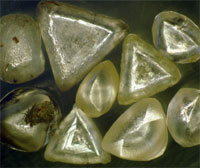
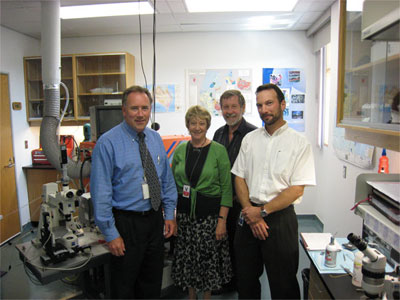 prospect of finding new deposits in Australia and abroad. The project will test the potential of trace-element microanalysis to fingerprint diamonds by source. If successful, this technology will provide economic benefits by reducing theft and illegal mining, which represent significant losses to legitimate companies. Application of this Australian development could reduce the circulation of “conflict diamonds”, which would have real social benefits worldwide, especially in some developing countries.
prospect of finding new deposits in Australia and abroad. The project will test the potential of trace-element microanalysis to fingerprint diamonds by source. If successful, this technology will provide economic benefits by reducing theft and illegal mining, which represent significant losses to legitimate companies. Application of this Australian development could reduce the circulation of “conflict diamonds”, which would have real social benefits worldwide, especially in some developing countries.